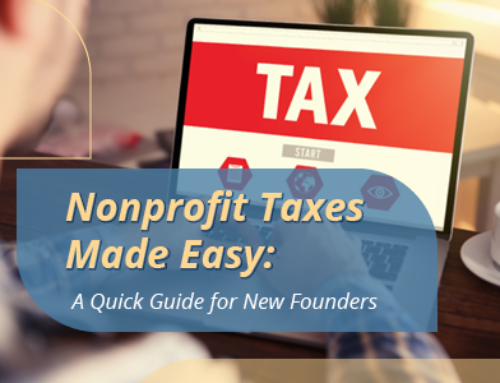 Success is not about being lucky. It’s about being prepared.
Success is not about being lucky. It’s about being prepared.
For new, young, and small nonprofits, it’s about systems and working smarter, not harder.
You see, success doesn’t come in a tidal wave. Success comes in slowly, like a pond gently rising from lots of Spring rain.
Simply, success is in the little details.

As you’re building your nonprofit, there are lots of small yet very important things you can do to secure your nonprofit’s future success. Many of these may seem too simple to matter but trust me that they do.
Take a little time now to handle these details and you’ll avoid some major headaches down the road.
After all, an ounce of prevention is worth a pound of cure.
10 steps to ensure your nonprofit’s future
1. Backup your computer. You already know this. But are you doing it? It’s like eating right. We all know we need to do it, yet so few of us do. Use a cloud-based service or a portable hard drive or something else– just do it. The last thing you want is to have all your program data or donor information on a laptop that crashes.
 2. Protect your website. Keep your site secure to prevent hacking and to keep it from going down. Use HTTPS to guarantee that donors are safe when they enter their credit card info on your site (use a tool like Let’s Encrypt to do that). Oh, and make sure your website is backed up regularly, just in case.
2. Protect your website. Keep your site secure to prevent hacking and to keep it from going down. Use HTTPS to guarantee that donors are safe when they enter their credit card info on your site (use a tool like Let’s Encrypt to do that). Oh, and make sure your website is backed up regularly, just in case.
3. Have more than one Admin on Facebook. It’s so easy to turn your social media or website over to a volunteer who says they’ll be happy to take care of it. Then that person vanishes or goes rogue and you just lost control of your online presence. The solution is easy – always more than 1 Administrator. Even if that person never posts a thing, they can still access the page or group through their Admin status and get you back in so you never get locked out.

4. Keep a password list. If you’re like me, I have a jillion passwords and there’s no way I can remember them. Plus, half the sites I use require me to change the password every 90 days (which actually is a really good idea). So, here’s what I do: I keep a Word file with a list of all my passwords and I keep it in a safe place. Lots of passwords are shared with my team, and we do that through a shared file in DropBox, but some are reserved just for me (personal banking info, credit card info, etc.). My assistant knows where the list is so if something happens to me and she needs to access stuff, she can. You can secure your file by adding a password to the file, too.
 5. Use a domain-based email. Have your whole team use an email that’s like sandy@horsehaven.org instead of sandyhorsehaven@gmail.com. It looks more professional and if the person leaves, you can access their email. It’s tough to recover a gmail address if they are using their personal one for nonprofit business (just saw this happen). Keep a list of all email addresses used for your nonprofit, who is using them, and the password for each one.
5. Use a domain-based email. Have your whole team use an email that’s like sandy@horsehaven.org instead of sandyhorsehaven@gmail.com. It looks more professional and if the person leaves, you can access their email. It’s tough to recover a gmail address if they are using their personal one for nonprofit business (just saw this happen). Keep a list of all email addresses used for your nonprofit, who is using them, and the password for each one.
6. Maintain an organization-wide calendar. This should be common knowledge, but like common sense, some things aren’t that common. Keep a master calendar of EVERYTHING going on in your organization, including vacations and conferences. It will help you prevent “gotchas” like those times when your program director invites a group of 20 homeschoolers to volunteer, but didn’t tell anyone, then is sick that day and now you have to come up with a job for them on the fly (saw this happen recently). Use a paper calendar, Google calendar, or a project management tool, but just do it. Put your fundraising events, marketing activities, volunteer recruitment and appreciation, and program dates. Also include deadlines for your charitable registration, 990 submission, and any other pertinent renewal dates so they won’t be forgotten, especially if the person responsible leaves. This will DEFINITELY ensure your nonprofit’s future success!
7. Have adequate insurance. Many people like to think that accidents won’t happen to them, but unfortunately no one is immune. Make sure you have enough liability coverage for yourself, your team, your program participants, and your volunteers, no matter if you have your own facility or use someone else’s facility. Check into director’s and officer’s coverage for your Board.

8. Create a system for departures. You probably have key staff or volunteers that you rely on to help make your organization function. Have you thought about what you’d do if they left? How will you make sure all the stuff they were doing continues to get done? What if they leave mad? It’s a good idea to have a checklist for what to do when someone leaves, including reassigning duties, changing passwords, gate codes, and locks. Even if the person leaves on good terms, it’s prudent to change passwords to protect your nonprofit.
 9. Write and use job descriptions. It’s easy when you run a really small nonprofit to think “everyone here just jumps in to help.” That may work for a while. But if you’re planning to grow, you need to delineate duties and create job descriptions so that volunteers and staff are crystal clear about the tasks they should be doing (and those that aren’t their responsibility). For example, if you have 4 volunteers who are running your organization, it’s important that everyone knows who can make decisions about adding people to programs or paying bills or talking to the media. If each of the 4 people try, you’ll get 4 different results because everyone does things differently, and that’s not really going to move you forward.
9. Write and use job descriptions. It’s easy when you run a really small nonprofit to think “everyone here just jumps in to help.” That may work for a while. But if you’re planning to grow, you need to delineate duties and create job descriptions so that volunteers and staff are crystal clear about the tasks they should be doing (and those that aren’t their responsibility). For example, if you have 4 volunteers who are running your organization, it’s important that everyone knows who can make decisions about adding people to programs or paying bills or talking to the media. If each of the 4 people try, you’ll get 4 different results because everyone does things differently, and that’s not really going to move you forward.
10. Store files in the cloud. This is one of our favorites! We use DropBox to store files and it makes life so easy to share among our team, access files from the office or home, and eliminates duplicate files because there’s not a copy on the hard drive, another on the jump drive and another on your home computer and you have no idea which one is the most current. Storing files in the cloud is super helpful if your computer dies. You get a new computer, log in to your file storage, and you’re back up and running in no time.
 The bottom line: The stronger your foundation, the more stable the structure is as you grow.
The bottom line: The stronger your foundation, the more stable the structure is as you grow.
Take the time to address each of these 10 areas, and you’ll be on your way to ensuring your nonprofit’s future is a bright one.






Leave A Comment